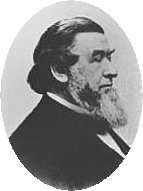Dixi Crosby
| Dixi Crosby | |
|---|---|
 Crosby, circa 1870 | |
| Born |
February 8, 1800 Sandwich, New Hampshire |
| Died |
September 26, 1873 (aged 73) Hanover, New Hampshire |
| Nationality | American |
| Occupation | Surgeon |
| Known for | Reducing metacarpophalangeal dislocation |
| Spouse(s) | Mary Jane Moody |
| Parent(s) |
Dr. Asa Crosby Betsey (Hoit) Crosby |
Dixi Crosby (February 8, 1800 – September 26, 1873) was an American surgeon and educator at Dartmouth College. He created a new technique for reducing metacarpophalangeal dislocation and was the first surgeon to open an abscess at the hip joint. Crosby was also the first surgeon in the United States to be sued for medical malpractice.
Early life and education
Crosby was born February 8, 1800 at Sandwich, New Hampshire, United States. His parents were Dr. Asa Crosby and Betsey (Hoit) Crosby.[1] Just before his birth, there was concern among his parents. Asa wanted a boy and Betsey wanted a girl. It turned out the new baby was a boy and Asa, the elated father, exclaimed "Dixi" in an overjoyed voice (Latin Dixi, "I told you so"). Dixi became the child's name.[2]
He received the typical education of the time when he grew up in the village where the family lived. It is not known if he was a graduate of any school. He did go into his own ventures to make money when youthful, but failed due to lack of experience in business. He then pursued his father's trade as a surgeon.[3]
Medical career
Crosby was 20 when he took up the study of medicine with his father. He began practicing surgery within a year from when he seriously took up his medical training. One example of a successful surgery in his first year of practice was when he performed an amputation of a leg to save a patient. His father and other surgeons had already declared that the patient could not survive such an operation – but Crosby saved his life.[1]
Crosby studied at Dartmouth Medical School and eventually received his degree from that college in 1824. He practiced his medical profession for fourteen years in various places within the state of New Hampshire and then moved to Hanover, New Hampshire. He was promoted in 1838 to the chair of surgery at the Dartmouth Medical School, which position he held until 1841. To this position was added obstetrics and other diseases of women and children. He lectured in these fields for 27 years.[4] Crosby led the successful drive to found a society supporting total abstinence from alcohol at Dartmouth in 1844.[5]
Crosby created a new technique of reducing metacarpophalangeal dislocation. He was the first surgeon to open an abscess at the hip joint.[4]
Crosby was the first surgeon in the United States to be sued for medical malpractice.[upper-alpha 1]
Later life and death
Crosby served in the provost marshal's office by day during the Civil War, and attended to his medical practice at night. The honorary doctor's degree of LL.D. was given to him by Dartmouth College in 1867. He ultimately turned over his medical lectures in 1868 to his assistant. Crosby retired in 1870 and was appointed emeritus professor of surgery. He lectured then from time to time whenever he desired.[4]
Crosby died at Hanover, New Hampshire, September 26, 1873.[2]
Personal
Crosby was cumbersome and awkward in his walk, although a well-dressed man. He had a large head with his hair in back reaching his coat collar. Crosby had a curly shaggy reddish beard that was never combed. He kept his upper lip clean-shaven so that no hair would obstruct his lecture speaking in the medical school. He had a positive attitude that was especially apparent when he talked as he walked.[2]
Crosby married Mary Jane Moody of Gilmanton, New Hampshire, in 1827. They had two sons. The first son, Albert H. Crosby (1828–1886) of Concord, New Hampshire, became a medical doctor even though he initially trained as a lawyer.[7] The other son, Alpheus Benning Crosby (1832–1877), became a professor of surgery at Dartmouth College.[8]
References
Notes
Citations
- 1 2 White 1907, p. 97.
- 1 2 3 Kelly 1920, p. 261.
- ↑ Kelly 1920, p. 262.
- 1 2 3 Wilson 1900, pp. 16–17.
- ↑ Squires 1956, p. 310.
- ↑ Davenport 1993, p. 24.
- ↑ Bell 1894, p. 292.
- ↑ Conn 1906, p. 388.
Sources
- Bell, Charles Henry (1894). The Bench and Bar of New Hampshire: Including Biographical Notices of Deceased Judges of the Highest Court, and Lawyers of the Province and State, and a List of Names of Those Now Living. Houghton, Mifflin.
- Conn, Granville Priest (1906). History of the New Hampshire surgeons in the war of rebellion. New Hampshire: Ira C. Evans, Company printers.
- Davenport, Horace Willard (1993). University of Michigan Surgeons, 1850–1970: Who They Were and what They Did. UM Libraries.
- Kelly, Howard Atwood (1920). A Cyclopedia of American Medical Biography: Comprising the Lives of Eminent Deceased Physicians and Surgeons from 1610 to 1910, Volume 1. W.B. Saunders Company.
- Squires, James Duane (1956). The Granite State of the United States: A History of New Hampshire from 1623 to the Present – Vol. 1. American Historical Association – via Questia (subscription required) . OCLC 3549431. Retrieved July 7, 2015.
- White, J.T. (1907). The National Cyclopaedia of American Biography, V9. J.T. White.
- Wilson, James Grant (1900). Dr Dixi Crosby. New York: Appletons' cyclopaedia of American biography. Retrieved June 24, 2015.